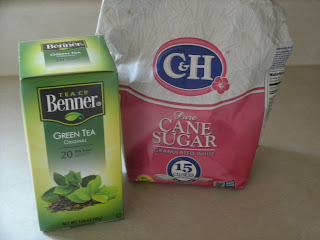Guyana
Today we are exploring Guyana with some bush tea. Well, not really bush tea, I didn't go out and pick the plants to make the tea, but I used the closest thing I had. The package of medicinal herbals that I received as a gift a couple of Christmases ago. I looked, they had not expired yet.
Some of the ingredients used in these teas could easily be foraged locally during the warmer months. Echinacea grows wild out here after all. Since echinacea has already been done, I decided to make the breathe easy one for this post. This tea has a long list of ingredients, but there was one that came through loud and clear to me: licorice root. It was actually the last ingredient, but it was the main thing I smelled when I made this.
While this may look like yet another innocent mug of tea that I would gladly slurp down, that is NOT the case. I hate licorice. I mean that stuff is gag reflex worthy. I honestly don't remember if I tried a sip or not. All I remember is the strong smell of licorice and the decision that I had done my part. Hopefully they have some plants that will make a better tasting bush tea in Guyana.
Speaking of Guyana, it is one of the smallest countries in South America, nestled between Venezuela and Suriname on the Atlantic ocean. Georgetown is the capital and a main port. Most of the cities are on the coast, and that is where most of the population lives. Guyana received full political independence in 1966 but is stall part of the commonwealth of British territories.
The coastal plain is only about 10 miles wide at its widest point, then the land transitions to rolling hills with marshes and swamps. The interior of the country sits on a low plateau that does transition into mountains. They are home to part of the tropical rainforest on that continent.
While the birth rate in the country remains high, the population is fairly stable due to migration to other countries to look for better opportunities. The largest part of the population is descended from the East Indians (laborers brought from India between 1838 and 1917) to work on sugarcane estates. The next largest population are the Afro-Guyanese who were brought to the country to work against their will by the Dutch and British. They gained their freedom in 1838. Native tribes make up less than one tenth of the population, and they tend to live in the interior and far west. Given their status as a former British colony, they are the only country in South America where English is the official language.
I guess it's time to get back to the decidedly non-tropical day here. Thanks to some warm weather, the mountains of snow we had have mostly melted, in time for a storm with "wintry mix" to come through tonight into Monday. We knew it was too good to last.





I hear you on licorice! My father-in-law loves licorice candies and sometimes I make homemade ones for him at Christmas. Not too often, though, because just the smell once I mix in the flavoring can be a little too much to handle.
ReplyDeleteI groaned in agony just at the thought of making licorice candy. He better appreciate them given how pungent that smell is (and the level of revulsion that smell can trigger). That's something you need to make in the summer when you can open the windows.
Delete